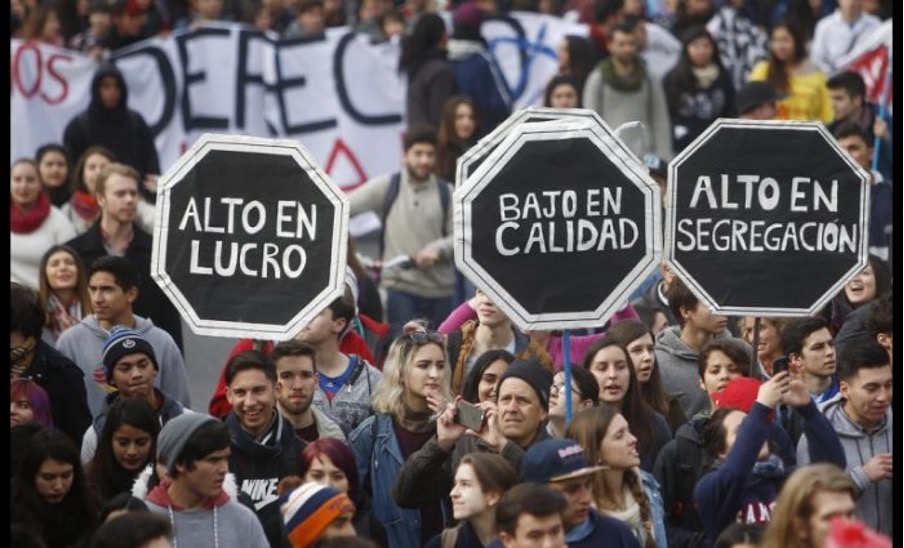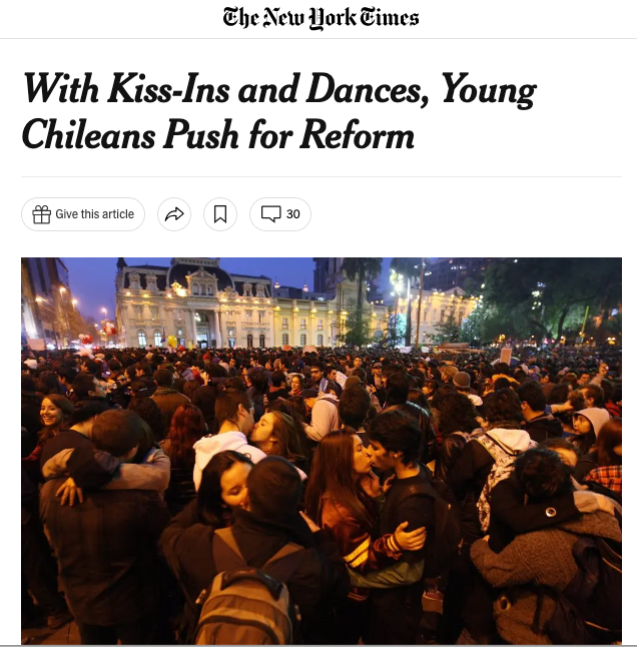On the second day of industrial action, as staff and students from UK universities participate in record numbers, Daniela Perez Aguilar and Cristóbal Villalobos Dintrans shed light on the Chilean approach to resistance drawing important comparisons between the participants and strategies for protest in the two countries.
In the context of the industrial action in the higher education (HE) sector in the UK today, we thought it would be illuminating to share our experiences of participation in social protests and strikes in Chile. Although both Chile and the UK have experienced similar processes of educational commodification and privatisation, the forms of resistance to these policies have been quite different, especially in HE. While in Chile they include diverse protest strategies such as symbolic expression, public assembly, and direct confrontation against the police, the classic form of protest in the UK remains the picket line. The goal of this post is to better understand the dynamics of Chilean protest and potentially extract lessons for the UK case.
Organisation and protest in education: persistence and transformation
Chile and Latin America have a vast and tragic history of social protest. Chile, in particular, experienced a series of political transformations mobilised by an active and highly politicised working class. However, the military dictatorship from 1973 through to 1990 persecuted union leaders, political activists, students, and anyone seen as a threat to the country’s stability. The implementation of policies of state terrorism weakened the social fabric woven during the 1960s and early 1970s. Consequently, many social organisations and unions went into latent mode or simply disappeared.
 Coverage of the student protests by El Mostrador, a leading digital newspaper in Chile
Coverage of the student protests by El Mostrador, a leading digital newspaper in Chile
In the field of education, schoolteachers and students are the groups who have kept alive the tradition of social protest which was a characteristic of the social movements of the 60s and 70s. Both these groups organised collectively to resist and challenge the neoliberal policies implemented in the educational system. From 1990 until 2014, school teachers led 24.25% of the protests recorded in the field of education. School teachers have demonstrated mainly through defensive protests, claiming economic demands (salaries mainly) especially through strikes and rallies, where the state was the main target. In this sense, teachers became a syndicalist-traditional protester with a strong alliance networks, especially with other national workers’ organisations, such as the Central Unitaria de Trabajadores.
Secondary and university students, on the other hand, developed more horizontal forms of organisation, efficient use of social networks, and strategic relationships with traditional politics, seeking to influence the public agenda and citizens. They also participated in more protests – between 1990 and 2014, secondary and postsecondary students participated in 80.93% of the protests in the education sector.
 A screen grab from the New York Times
A screen grab from the New York Times
Although they kept using traditional strategies of protest, such as marching on the streets in large numbers, as well as occupying schools (especially in the last decade), they also used new strategies. The use of social media and more creative ways of protesting and expressing discontent, captured the attention of international media sources such as The New York Times, The Washington Post, and The Economist. The impact of the massive participation and the high levels of disruption created allowed the students to redirect the national agenda. One of the most significant achievements of this movement was a free-tuition policy for working-class students after 30 years.
University teachers and educational protest: between apathy or privilege?
Unlike schoolteachers and students, university professors and academics have a limited presence in educational protests in Chile, with only 2.79% of the protests led by this group. This number is useful for at least three reasons. First, in general, university teachers see themselves as different from schoolteachers and do not feel they are a key player in the education system. Second, academics still occupy a privileged position and seem much less politicised than schoolteachers. This is especially true in Chile, where less than 0.1% of the population has a Ph.D. and which is the preserve of privileged socioeconomic groups, constituting a knowledge elite. Finally, unlike what happens in the UK, in Chile, academics are not organised at a national level, and in many universities, they do not have unions either, since academia is considered to be just another market.
These conditions could explain the low participation of academics in protests. However, this does not imply that academics do not experience the impact of neoliberalism in their lives and work. In fact, many of us experience the difficulties of a hyper-competitive environment, with precarious jobs, little time for research and low appreciation for teaching, as well as the imposition of evaluation metrics that make it difficult to investigate complex problems and promote a distance from the community.
Chile and UK: different strategies to resist commodification and precarity
When comparing Chile and the UK, one of the most striking differences is that although Chile has a long tradition of social mobilisation in the educational sector, it had been led mostly by students and schoolteachers, marked by a near absence of academics. The second difference is the tactics used by different groups to demand transformation. In the case of Chile, the use of public space and the introduction of new forms of protest, as well as the organisation at the national level with coordinated actions, has been essential to the success of these tactics. In contrast, the actors in the UK continue to use traditional methods of protest such as signing of petitions and disruptions within HE institutions.
is the picket line still the most effective tactic when we want to create disruption inside universities instead of factories?
Final reflections
The trajectory of social protest in the field of education in Chile and the varying dispositions of schoolteachers, students, and academics illuminates the practice of resistance in other parts of the world. We want to draw three final reflections based on our experiences as former Chilean students (both), PhD students (Daniela,) and researchers in education (Daniela and Cristóbal).
The first one is the importance of the historical trajectory and identities of the social groups involved. In the case of Chile, multiple stars aligned to facilitate the emergence of major social protest. This generation of students is the first to be born in a democracy and has not experienced the violence and repression faced by prior generations, which allows them to be more creative and confrontational in their tactics. Compared to schoolteachers, this generation of students challenged structural visions of the educational system and organised themselves in a more horizontal form, making their influence felt across Chilean society. Attaining this level of clarity on the importance of the demands and the strategies used to achieve them requires time and work on a collective vision of the future. On the other hand, unlike the UK, Chilean academics seem to be at a stage where collective organisation and potential resistance is not a priority on their agenda yet.
The second point we would like to raise is the importance of the tactics and strategies selected to achieve their goals. Although students relied primarily on classic tactics such as marches and occupations (that permit disruption in routines), there were specific events which caught the attention of the public and the media. This marked a change in how protests were performed, garnering the support of civil society and the attention of the leading news and social media channels. This performative aspect, in conjunction with the instrumental dimension of the protests, planted a new seed in the people’s vision of how to resist the system and allowed them to understand the protest as an act that contributes to changing policies in the future, but at the same time, generates transformations in society in the present. The importance of the use of public space to position these demands as issues concerning society in general were key to the success of these movements. This raises a question of the tactics we use to protest, their origin and adequacy: is the picket line still the most effective tactic when we want to create disruption inside universities instead of factories?
Finally, we believe it is crucial to consider educational spaces as integrated systems. Although we have seen more coordination between secondary students and teachers in recent years, there seems to be a fragmentation of actors at the higher education level with low participation rates for researchers and academics. It would appear that students, schoolteachers, and academic staff have different interests to defend. However, coordination between actors is crucial to achieving change. Promoting conversations, creating joint activities, and imagining shared visions of the future between teachers, academics, and students are thus essential to generate productive protests.
If the aim is to generate disruption and position the demands of the sector in the political agenda as an urgent matter, gaining clarity of the stages the different groups are at; the introduction of innovative methods of protesting whilst continuing to employ those that have worked in the past; and fostering collective and collaborative work among the different agents of change whilst acknowledging the subjective and objective conditions of the field seem essential to any possible transformation.
_________________________________________________________________________________________________________________________
This post is opinion-based and does not reflect the views of the London School of Economics and Political Science or any of its constituent departments and divisions.
_________________________________________________________________________________________________________________________
Main image: Courtesy El Mostrador



